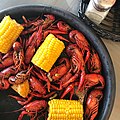Crayfish
Crayfish are crustaceans that are also known as crawdads, crawfish, kriddly wigs, and freshwater lobsters.[1] they are closely related to lobsters, crabs, and shrimp. There are about 150 crayfish species in North America, and over 540 species worldwide.
| Crayfish | |
|---|---|

| |
| Scientific classification | |
| Kingdom: | |
| Phylum: | |
| Class: | |
| Subclass: | |
| Order: | |
Most live in freshwater habitats such as rivers.
Anatomy
The body of a decapod crustacean, such as a crab, lobster, or prawn (shrimp), is made up of twenty body segments. They are grouped into two main body parts, the cephalothorax and the abdomen. Each segment may have one pair of appendages. In some groups these may be reduced or missing. On average, crayfish grow to 17.5 centimetres (6.9 in) in length, but some grow larger. Walking legs have a small claw at the end.
Habitat
Crayfish live in streams, rivers, swamps, ponds, and other freshwater habitats. Most crayfish are strictly aquatic but some live in semi-aquatic environments. The semi-aquatic crayfish burrow into the soil to get to water (so that they can breathe). Some can also be put in private aquarium to be used as pets
Diet
Crayfish are omnivores; they eat plants, animals, and decaying organisms. They are nocturnal (most active at night) and eat fish, shrimp, water plants, worms, insects, snails, and plankton. Larval crayfish are very tiny; they eat plankton.
Name
Crayfish might be sometimes be called crawfish in parts of the U.S.A.
Further reading
- Thomas Henry Huxley (1880). The Crayfish: an introduction to the study of zoology. New York: D. Appleton & Co.
Crayfish Media
Rearing white-clawed crayfish at Cynrig hatchery, Wales. Establishing a breeding population from introduced captive-bred animals.
References
- ↑ C. W. Hart Jr. (1994). "A dictionary of non-scientific names of freshwater crayfishes (Astacoidea and Parastacoidea), including other words and phrases incorporating crayfish names". Smithsonian Contributions to Anthropology. 38 (38): 1–127. doi:10.5479/si.00810223.38.1. hdl:10088/1372.

